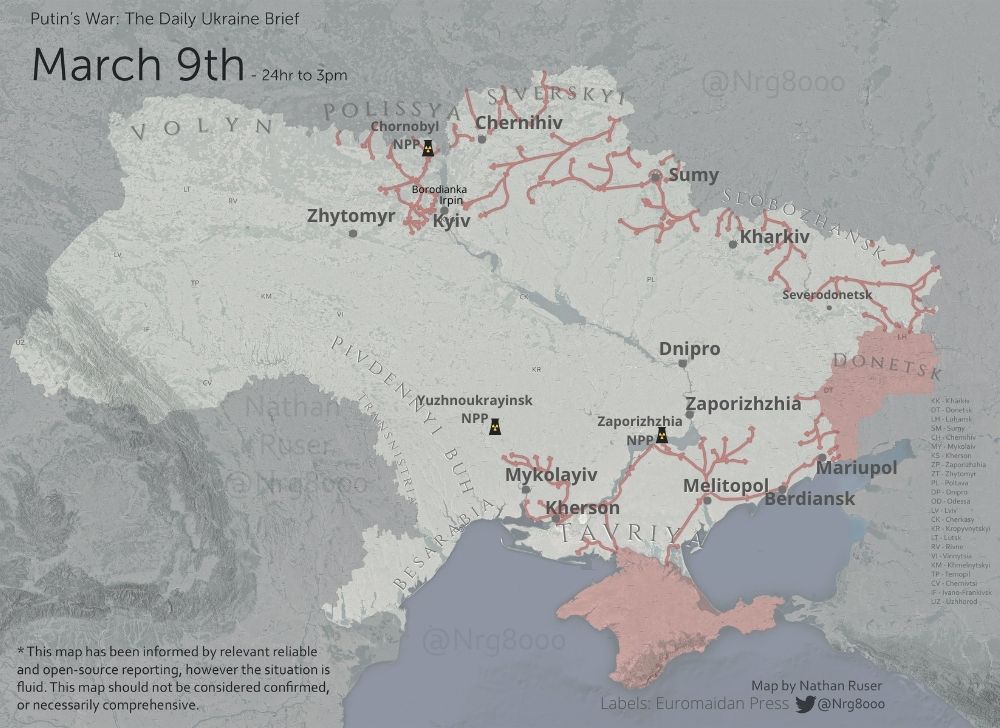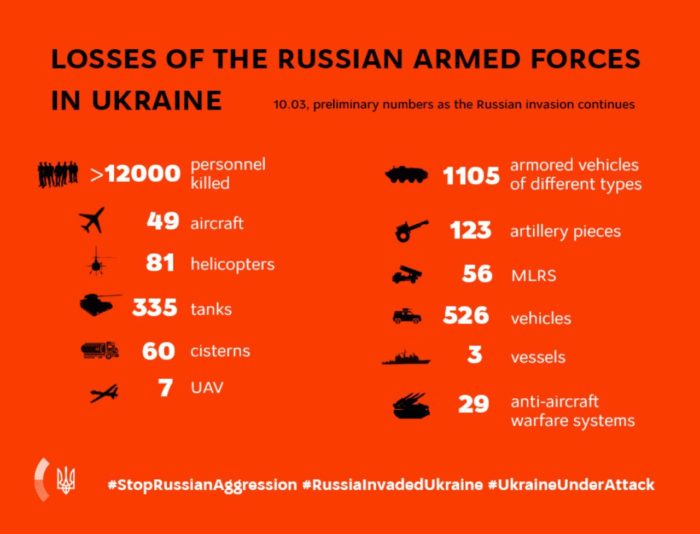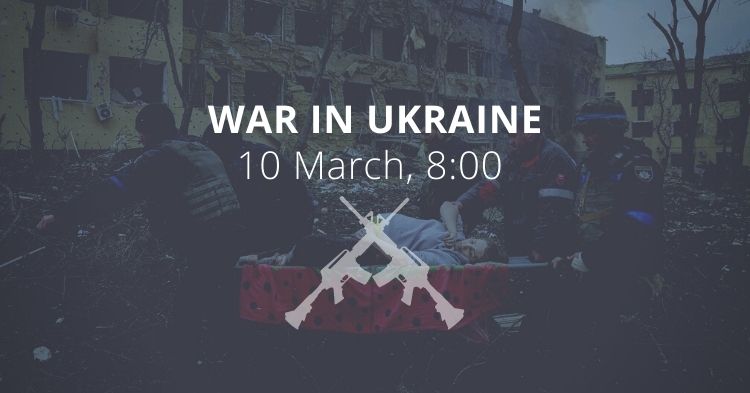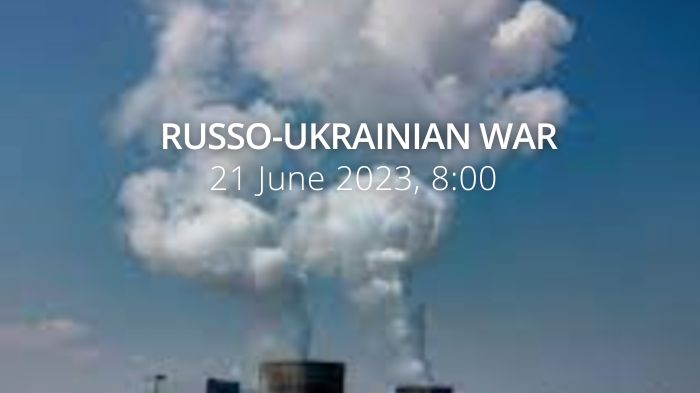Morning report day 15 - March 10
The report is based on media reports, expert analyses, and official information posted online.
BTG: Battalion Tactical Group, approximately 600–800 officers and soldiers, of whom roughly 200 are infantrymen, typically equipped with roughly 10 tanks and 40 infantry fighting vehicles.
Situation
According to information from the General Staff of Ukraine as of Operational information on 06.00, 09.03.2022 and [midnight]:

“[Ukraine's defense forces are repelling and holding back the offensive of the Russian armed forces in all directions.]
Ukraine's defense forces continue to hold back the offensive of the Russian Armed Forces in Donetsk, Slobozhansky, and parts of the Tavriya operational areas. Defending the Ukrainian cities of Kharkiv and Okhtyrka. The main efforts are focused on preventing the enemy from advancing in the south-eastern direction. The circular defense of the city of Mariupol continues.
[In some of them, the occupying forces lost their combat capability and put reserves into operation. In order to increase its combat capabilities, the enemy moves units and military units from other strategic directions to the borders of Ukraine.]
At the same time, the state border with the Republic of Belarus continues to be covered [by the Ukrainian Armed Forces].
[The Republic of Belarus provides support to the occupier in ensuring the supply of fuel and oil, the use of railway infrastructure, and airfield network.]
[Sabotage of military and civilian infrastructure remains likely.]
[The Russian federation is not abandoning plans to encircle Kyiv, continuing the offensive operation in the Polissya and Siversky directions.]
In the Siverskyi region, Ukrainian defenders are defending the city of Chernihiv. Measures are being taken to deter the enemy from advancing in the direction of Kyiv.
The group of forces and means of defense of the city of Kyiv is constantly ready to repel the enemy's offensive, inflicts fire damage on the offensive group of occupiers, and maintains certain defensive lines.
[In the Slobozhansky direction, the enemy attacked the settlements of Izium, Petrovske, Hrushuvakha, as well as the cities of Sumy and Okhtyrka.]
[The enemy offensive also continues in the Donetsk and Tavriya directions.]
In the southern direction, the enemy is held back in the directions of the cities of Kryvyi Rih, Mykolayiv, Voznesensk, and the settlement of Novovorontsovka (Kherson region).
[The enemy increases the grouping of troops in the Mykolayiv direction
.]
[In the Black Sea and Azov operational zones, the occupiers continue to isolate the area of hostilities. Naval groups of the Russian Armed Forces are located in the areas of Cape Tarkhankut and Lake Donuzlav.]
In other areas, groups of troops are conducting a stabilization operation and performing territorial defense tasks.
Units of the Air Force of the Armed Forces of Ukraine repel missile and bomb strikes and destroy enemy air strikes, providing air cover for important objects of Ukraine and groups of troops.
Over the past two days, fighter jets and anti-aircraft missile units have destroyed four Su-25 attack aircraft and two enemy helicopters.
[The Armed Forces of Ukraine, in coordinated cooperation with other components of the security and defense sector of the state and the forces of national resistance, are restraining the massive offensive of the occupying forces.]
The enemy reduced the pace of the offensive, its personnel demoralized. The number of cases of desertion and looting has significantly increased.”
According to the State Border Guard Service of Ukraine, 14,500 thousand returned to Ukraine. Almost 12,000 of them are Ukrainians, most of them men planning to join the defense forces.
- The large Russian column northwest of Kyiv has made little progress in over a week and is suffering continued losses at the hands of the Ukrainian Armed Forces.
- There has been a notable decrease in overall Russian air activity over Ukraine in recent days, likely due to the unexpected effectiveness and endurance of Ukrainian Air Defence forces.
- Russia has deployed conscript troops to Ukraine despite previous public assurances from President Putin not to do so. As casualties mount, President Putin will be forced to draw from across the Russian Armed Forces and other sources to replace his losses.
https://twitter.com/EuromaidanPress/status/1501625196284940295https://twitter.com/EuromaidanPress/status/1501600208119078917
- Experienced mercenaries from Russian Private Military Companies (PMCs) are likely deploying to fight in Ukraine to support the Russian invasion.
- The Russian state almost certainly maintains extensive links with Russian PMCs, despite repeated denials.
- Russian PMCs have been accused of committing human rights abuses in several countries, such as Syria, Libya, and the Central African Republic, whilst operating on behalf of the Russian state.

As of 10.03.2022 morning, the approximate losses of weapons and military equipment of the enemy of the Russian Armed Forces from the beginning of the war to the present day:
- personnel – more than 12.000 people (no change),
- tanks – 335 units (+18),
- armored combat vehicles – 1105 units (+35),
- artillery systems – 123 (+3),
- multiple rocket launchers – 56 (no change),
- air defence means – 29 (+1),
- aircraft - 49 (no change (?)),
- helicopters - 81 (no change (?));
- automotive technology – 526 (+44),
- light speedboats - 3 units (no change),
- fuel and lubricant tanks – 60 (no change),
- UAV operational and tactical level – 7 (no change).
Humanitarian
The head of the UN's refugee agency, Filippo Grandi, warned that the second wave of refugees is likely to be more vulnerable than the first, Infomigrants report.
"If the war continues we will start seeing people that have no resources and no connections," he said at a press conference in Oslo. "That will be a more complex situation to manage for European countries going forward," adding that "even more solidarity" will be needed in Europe and beyond.
According to Ukrainska Pravda the situation in the regions are as follows:
- Kyiv Oblast. Fighting in Irpin continues. The evacuation by car lasted for almost two nights from the direction of Irpin-Bucha-Vorzel. The enemy did not allow the evacuation of Borodyanka, Gostomel and Bucha. Fighting and shelling in Makarov. In the Vyshhorod district - shelling near Lutezh. Brovary district - fighting and shelling in three communities. Constant aviation alarms throughout the region
- Chernihiv Oblast. Several air alarms per night. Defensive battles near Chernihiv.
- Sumy Oblast. Russian aircraft again bombed residential areas of Okhtyrka. Strikes on the territory of the Kachanivsky Gas Processing Plant's tank farm. As a result of the bombing, oil tanks were destroyed (1777 tons).
- In Trostyanets - shelling of the former plant "Electrobutprilad". As a result, three citizens died, including a minor. In Bilopillya in the evening as a result of an airstrike TV sets were damaged, the fire was extinguished. No one was killed or injured. After midnight there was a second enemy attack in the village of Bytytsya, with no casualties.
- Corridor agreements reached: evacuation from Sumy, Trostyanets, Krasnopillya scheduled for March 10
- Zhytomyr Oblast. In the evening and at night 3 air alarms. Airstrikes on Zhytomyr and nearby settlements. More than 10 residential buildings, the city's thermal power plant was damaged, and windows in the city hospital building were broken. Bombing of the city of Korosten: the base of one of the gas station operators was damaged, as well as the private sector. 6 citizens were injured, 1 died.
- Zaporizhzhia Oblast. Situation unchanged. More than a thousand people in the evacuation column from Energodar arrived in Zaporizhzhia. The evacuation was accompanied by the Ukrainian Red Cross. In the cities of Melitopol and Berdiansk, the enemy seized the local media and began to conduct pro-Russian propaganda.
- Vinnytsia. During the night there was an air alarm three times. In general, calm.
- Rivne Oblast. One air alarm at night. In general, calm.
- Volyn, Zakarpattia, Khmelnytsky region, Ternopil, Cherkasy, Chernivtsi, Lviv, Ivano-Frankivsk, Poltava region, Kirovohrad region, Odesa and Dnipropetrovsk oblasts. The situation is generally calm. One air alarm during the night in some regions.
- Kharkiv. In the city itself, the occupiers destroyed the largest shopping centre, no one was injured, there were isolated attacks from residential areas from the air. In the area of the Armed Forces, Dergachi was repulsed, and fighting is taking place in Izium.
- Luhansk Oblast
- At 4.30 there was heavy shelling of Sievierodonetsk. Damaged gas pipeline, residential buildings. One was killed, 2 wounded.
- Lysychansk: 2 houses were damaged. Rubizhne: heavy shelling at night, hit the House of Culture in front of the City Council, One killed, 2 wounded. Also in the evening, the Russians fired on Popasna and hit the city hospital.
- Donetsk Oblast
- In Mariupol there were battles all night, planes over the city, artillery worked. The ruins of the maternity hospital, hospital and university building destroyed by the airstrike are being dismantled. The city is controlled by Ukrainian troops.
https://twitter.com/EuromaidanPress/status/1501730827725647880 - There were heavy ground and artillery battles in Volnovakha. The city is Ukrainian.
- Kostiantynivka: Iskanders fired at the railway, wagon depot buildings and power lines were destroyed. In Druzhkivka, heavy artillery shelling destroyed private buildings.
- Kramatorsk: there were air alarms at night and in the morning.
- In Mariupol there were battles all night, planes over the city, artillery worked. The ruins of the maternity hospital, hospital and university building destroyed by the airstrike are being dismantled. The city is controlled by Ukrainian troops.
- Mykolaiv. In the evening Mykolayiv was fired upon. There were explosions in the night. In another part of the region, the night was calm
- Kherson region. The city was quiet at night, but there were constant explosions on the outskirts of the city.
Legal
Russian war crimes in Ukraine may force NATO to rethink its force posture, CBS reports.
"We see yet another example of the targeting of civilians. This is a war crime," said retired General Tom Lawson, former chief of the defence staff, of the apparent Russian airstrike on a maternity ward in Mariupol. "We may see that NATO has to rethink...how they go forward with Russia.".
Environmental
The United Nations nuclear watchdog has lost touch with its remote systems that monitor nuclear material at the Zaporizhzhia nuclear power plant in Ukraine, Reuters reports.
“Zaporizhzhia, Europe's largest nuclear power plant, has been in Russian hands since last week, when a blaze broke out in a building at the site after clashes between Russian and Ukrainian forces. The International Atomic Energy Agency (IAEA) announcement came a day after it said the same thing had happened at the radioactive waste facilities at Chernobyl, near the defunct power plant that was the site of the world's worst nuclear disaster in 1986. Both sites are under Russian forces' control but are being operated by Ukrainian staff in conditions that the IAEA says endanger the safety of the facilities.)”
Support
Britain considers giving ‘Starstreak’ air-defense weapons to Ukraine, DefenceNews reports.
”Starstreak is a high-velocity missile designed to provide air defence against helicopters, low flying fixed-wing jets and unmanned air vehicles out to a range upwards of 4 miles. Issues such as training still had to be resolved. Britain will also supply limited numbers of Lockheed Martin- and Raytheon-built Javelin anti-tank missiles alongside non-lethal items such as ration packs and medical supplies."
NATO Allies have been stepping up support for Ukraine, imposing costs on Russia, and bolstering NATO deterrence and defence, NATO Secretary-General Jens Stoltenberg at the Ottawa Conference on Security and Defence Wednesday.
“Allies are providing more military, humanitarian, and financial aid to Ukraine to help it uphold its fundamental right to self-defense, as enshrined in the UN Charter. At the same time, we are imposing unprecedented costs on Russia, targeting Russian companies, banks, and energy suppliers, as well as oligarchs close to President Putin. NATO has a responsibility to ensure that this conflict does not escalate beyond Ukraine because this would be even more dangerous, destructive, and deadly. Allies are also significantly increasing our defensive presence in the east of our Alliance with thousands more troops, and hundreds more aircraft and ships. More than doubling our presence there in the recent weeks."
New developments
- Dmytro Kuleba, Ukraine's outspoken foreign minister, spoke with his Russian counterpart, Sergei Lavrov in Türkiye, Sky News report. It marks the highest-level talks to be held since the conflict began. Speaking at a press conference after the talks, Kuleba confirmed his previous low expectations for them:
"We cannot stop the war if the attacking country has no desire to do so. Today I heard that Russia ties a ceasefire to demands made by the Russian president to Ukraine. I stress that Ukraine has, is not, and will not surrender.... As long as there are no diplomatic solutions, we will selflessly sacrifice ourselves to protect our people from Russian aggression," Kuleba said.
Kuleba said he came to talks with two goals: to organize a humanitarian corridor from Mariupol and agree on a 24-hour truce.
- The Pentagon has deployed thousands of additional troops to Europe, including 500 more US troops announced Monday, CNN reports. The US is sending defensive weapons like Patriot missiles to Poland and considering moving additional assets to protect other allies like Romania and the Baltic nations of Latvia, Lithuania and Estonia from any Russian moves on their borders, officials say.
Assessments
1. On the War
Wednesday 9 March, Defence Secretary Ben Wallace gave a statement to the House of Commons on Ukraine.
Russian high command [initially] committed 65% of its entire land forces, which are indisputably in possession of overwhelming firepower and armor. It is estimated that at the start of the invasion they had between 110 and 120 battalion tactical groups dedicated to the task, compared with approximately 65 in Ukraine. Their missile stocks gave them even greater strength to reach Ukraine at distance. However, what they did not and still do not possess is the moral component so often needed for victory.
After 14 days of the war, according to the Ukrainian general staff, on 6 March, Russian casualties were assessed to include 285 tanks, 985 armored fighting vehicles, 109 artillery systems, 50 multiple launch rocket systems, 44 aircraft, 48 helicopters, and 11,000 soldiers, who have lost their lives needlessly. There are numerous reports of surrenders and desertions by the ever-growingly disillusioned Russian army. To be clear, those are Ukrainian figures; I have to caution the House that we have not verified them by defense intelligence or other means.
I can announce to the House our assessment that, of the initial Russian objectives, only one has been successfully achieved
. While Russian forces are in control of Kherson, Melitopol and Berdiansk in southern Ukraine, they currently encircle the cities of Chernihiv, Sumy, Kharkiv and Mariupol but are not in control of them. In addition, their first day objective of targeting Ukrainian air defense has failed, preventing total air dominance. The Ukrainian armed forces have put up a strong defense while mobilizing the whole population. President Putin’s arrogant assumption that he would be welcomed as a liberator has deservedly crumbled as fast as his troops’ morale.”
[bctt tweet="President Putin’s arrogant assumption that he would be welcomed as a liberator has deservedly crumbled as fast as his troops’ morale" username="EuromaidanPress"]
2. Support and consequences
“President Putin totally underestimated the strength of the Ukrainian Armed Forces,” NATO Secretary General Jens Stoltenberg told the press yesterday. “And they have been able to push back, to fight back, and to slow down the Russian advances. And this is, first and foremost, the result of the courage of the Ukrainian Armed Forces and the support and the courage of the Ukrainian people."
NATO Allies especially the United States, United Kingdom, Canada, but also, Türkiye have provided equipment and military aid. [Due to several factors, including the Minsk agreement and the hope for a peaceful resolution of the conflict, the countries did not start delivering defensive weapons until 2018] And they are now on the front line. So this support has proven to be crucial for the strength of the Ukrainian army. And we are now stepping up support with more supplies.
And I think also we have to realize that compared to where the Ukrainian army was in 2014, the training NATO Allies have provided, the equipment NATO Allies have provided since 2014 has made the Ukrainian Army much better trained, much better equipped, much better commanded, and much stronger. And this is the reason why they are able to push back the way they are able to do.”
In an article published in December 2021, Atlantic Council pointed out that
“equipment coming from foreign military assistance covers some of the tactical gaps of the armed forces. For a long time, such assistance did not include lethal weapons to Ukraine, which [was] in the eighth year of war. Only the United States and Lithuania have provided such support [as of December 2021].”
That needs to be seen in the context of the starting point of the immense transformation we have witnessed in the last two weeks.
[ ] The spending per service person (full-time equivalent) is one of the lowest in Europe. Ukraine’s defence budget is one of the highest in terms of percentage of GDP (around three percent) even for NATO member states. However, the UAF started the war with a huge “backlog” after years of neglect and downsizing with most equipment obsolete. [ ]
Even though the military has been prioritized for the last seven years, it has been impossible to overcome decades of neglect. The UAF therefore still has several enduring strategic vulnerabilities. Funding is limited due to the general economic conditions of the country. Ukraine has been forced to down-prioritize many important acquisitions, not for lack of will, but due to a desperate lack of funding.
Ukraine started to reform its armed forces during the active phase of the war, which naturally distracted the attention, resources, and time of commanders and political leaders. Most reform decisions and actions were taken prudently and cautiously.”
We pointed out that “the combat capabilities, readiness, and practical skills of Ukraine’s Armed Forces, Special Operations Forces, and National Guard have reached much higher levels compared to 2014. Ukraine has gained invaluable experience of war, given the duration and multidimensional nature of the ongoing conflict. This experience is studied and analyzed by military and civilian experts who regularly come to Ukraine. The multinational training of the Ukrainian Armed Forces in the framework of military assistance is recognized by partner countries as a mutually beneficial exchange of experience.”
We also highlighted the critical gaps in key operational and combat capabilities, namely Navy, Air Defence, and Tactical Aviation. During his visit to Washington in August 2021, president Zelensky presented his plan for the transformation of Ukraine. This included a request for $25 billion to rearm Ukraine’s military. According to the plan, on its own, it would take Ukraine some 30 years to implement the projects. With international assistance, they could be completed by 2025.
The article argued that “although, in our opinion, the planning and application of foreign aid can be improved, it has already had a significant effect on the capabilities of the Ukrainian military. It has significantly improved the tactical and operational training of combat units. In addition, it has contributed to the development of new capabilities. There are outstanding examples of the use of foreign military assistance, such as the development of Ukraine’s Special Operations Forces and the creation of a modern International Security and Peacekeeping Center. In both cases, success was defined by a comprehensive approach to developing specific capabilities, clear and measurable objectives, and close partnership with NATO member states.
Ukraine conducts a series of regular military exercises with allies on its territory. It provides advanced training for personnel. The positive impact of this can be seen in the historical certification of a non-NATO Ukrainian unit to join the NATO Rapid Response Force in 2019.
Foreign military experts involved in cooperation programs also emphasize that Western forces consistently learn from the Ukrainian experience of modern warfare.
Planning and evaluation of foreign military assistance are carried out jointly within the framework of the Multinational Joint Committee (MJC), a body that has been planning military assistance from allied countries since 2014.”
The reason I am returning to past assessments is trifold.
- Firstly, to highlight the fact that it was a few dedicated NATO members – not NATO - that helped Ukraine prepare for what happened on February 24. The last years had demonstrated that while NATO may unite around statements of concern or condemnation, it has become increasingly difficult to have it unite on deterrence, capability building and the NATO defence budget target. Even though Ukraine is not a NATO member, NATO deterrence failed all the same on February 24 given its commitment as laid down in its strategic concept. This needs to be acknowledged moving forward.
- Secondly, we need to recognize the psychological impact of real practical support. In 2014 already Ukrainians started talking about the West as the “nations of concerned”, referring to the many statements and the lack of real, practical defence support. Defence aid has an impact way beyond the practical application of weapons. It shows real intent and commitment. It helps both to increase the morale of the victim as well as reduce the will of the aggressor. It sends a clear message, avoiding the risk of miscalculation and strategic blunders.
- Thirdly, now more than ever, it is important to give credit where credit is due. The support from the Multinational Joint Commission countries was very important, but the main achievement rests with Ukraine itself. The first defensive weapons arrived four years into the war, and the great majority arrived after Russia started its full-scale invasion.





